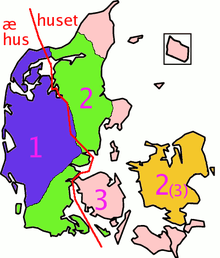Gender in Danish and Swedish

In Danish and Swedish, nouns have two grammatical genders, and additionally people have two natural genders similar to English.
Overview
Historically, nouns in Danish and Swedish, like other Germanic languages, had one of three grammatical genders: masculine, feminine, or neuter. Over time the feminine and masculine genders merged into a common gender. A common gender is also partly used in some variants of Dutch, but in Dutch the merging is not complete, with some vestiges in pronouns. Danish and Swedish have no such vestiges, since they unlike Dutch and German do not use the same pronouns for objects and people, but like English have natural gender personal pronouns for people, and separate grammatical gender pronouns for objects and animals.
Whereas standard Danish and Swedish are very similar in regard to noun genders, many dialects of Danish and Swedish have separate numbers of grammatical genders, from only one, and up to three. Norwegian while similar to Danish and Swedish, uses three genders in its two standard versions, but some dialects, like that of Bergen, and the Riksmål dialect of Bokmål uses two.
History and dialects
Around 1300 Danish had three grammatical genders. Masculine nouns formed definite versions with -in (e.g.: dawin — the day, hæstin — the horse), feminine with -æn (kunæn - the woman, næsæn — the nose), and neuter with either -æt or -it (barnæt - the child, skipit - the ship). In some dialects, like East Jutlandic, Copenhagen and Stockholm, the -in and -æn suffixes merged to -en forms thereby losing the distinction between the two.[1] Other dialects kept the distinction, like Insular Danish, where only the feminine suffix became -en while masculine form lost the n and became -i (dawi - the day, katti - the cat), or Norwegian and North Swedish where the masculine definite suffix became -en, but feminine lost the n and became -a (mora/måma — the mother).
Grammar
Pronouns
Like in English, accusative and dative cases are merged to one objective case and is only marked on object pronouns.
| Nominative | Objective | Possessive | |
|---|---|---|---|
| Masculine (natural gender) | han | ham / honom | hans |
| Feminine (natural gender) | hun / hon | hende / henne | hendes / hennes |
| Common (grammatical gender) | den | den | dens / dess |
| Neuter (grammatical gender) | det | det | dets / dess |
Articles
North Germanic languages use a definite suffix (or enclitic article) instead of a definite article, except when a preposition is attached to the noun, then a definite article is placed in front. Because these normally attach to common nouns and not proper nouns, they are usually not used for people. The only exceptions are as an epithet or a description, in which case the definite article for the common gender is used.
| Indefinite article | Definite article | Definite suffix | |
|---|---|---|---|
| Common gender | en | den | -en |
| Neuter | et / ett | det | -et |
Neutral natural gender
Due to using natural genders for people, a problem arises when discussing a person of unknown or undefined gender. Traditionally the masculine pronouns have been used in that case, but that has caused some concern about cultural sexism. As a solution some feminists in Sweden have proposed to add a third class of gender-neutral pronouns for people.[2] This is used in some places in Sweden. The Danish translation is added in parenthesis, but is not actually used, and lacks objective and possessive versions.[3] In 2015, hen was introduced in SAOL, the glossary of the Swedish Academy.[4]
| Nominative | Accusative/Dative | Possessive | |
|---|---|---|---|
| Neutral (natural gender) | hen (høn) | hen/henom ( - ) | hens ( - ) |
See also
References
- ↑ "Naveneordernes køn". Copenhagen University, Centre for Dialect Research.
- ↑ Margret Atladottir (29 February 2012). "När könet är okänt". Retrieved 26 July 2014.
- ↑ "Nyt fra Sprognævnet 2002 nr. 3" (PDF). 2002. Retrieved 2015-03-24.
- ↑ http://www.dn.se/kultur-noje/spraket/hen-med-i-ordlistan/